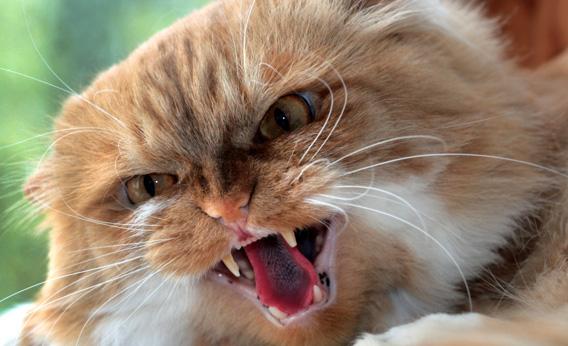When Felines Attack
Do house cats ever kill people?

Scary cat
Photo by Anna Sematkina/iStockphoto/Thinkstock.
Photo by Anna Sematkina/iStockphoto/Thinkstock.
An Illinois man planned to kill a rival for his wife’s affections by electrocuting him and then framing the victim’s cat
for the murder. Brett Nash was arrested for the bizarre plot in January
and pleaded guilty on Tuesday. Do cats ever kill people?
Not grown-ups. Rabies deaths notwithstanding, the Explainer is
unaware of any incidents in which a house cat has killed its able-bodied
adult owner. Cats can, however, inflict a pretty gruesome mauling. In
2010, a postpartum cat in Idaho bit her owner 35 times,
going back for a second round of scratches and bites after the owner
washed off the blood. Last year, a Cleveland man was airlifted to a
hospital after a brawl with his tabby cat. Fights with humans usually don’t end well for felines. The New York Times reported a dramatic scene in 1921, when a pet Angora clamped down on the finger of a Manhattan woman who was riding in the tonneau
of her husband’s car. The husband responded by strangling the cat to
death, although that didn’t stop an arriving police officer from drawing
his weapon against the lifeless feline. It wasn’t the last time the
NYPD had to face down a house cat: A year later, after being bitten by a
cat on Columbus Avenue, a police officer shot the animal dead with his revolver.
Cats occasionally kill infants, but the deaths are accidental. In the
early 1980s, a Norwegian father discovered his cat sleeping on the face
of his 5-week-old baby. Although the father administered CPR, the child
eventually died from the aftereffects of asphyxiation. (A doctor’s
report suggested that cats might be responsible for some cases of sudden infant death syndrome.) In 1931, a Connecticut cat took a nap on the chest of a 4-month-old child, smothering him. There were several reports of similar incidents in the 19th century.
Smothering deaths appear to have given rise to a widespread myth that cats suck the breath from sleeping infants. The cat was supposed to have aligned its nostrils
with those of a sleeping baby, using its chin to hold the child’s mouth
shut. The cat’s motivation varies depending on who tells the tale. Some
say cats are drawn irresistibly to the smell of breast milk on a baby’s
breath, while others believe jealousy is to blame. Ernest Hemingway
called proponents of the wives’ tale “ignorant and prejudiced,”
and bragged that his own cat, Feather Puss, guarded his son while he
slept. Physicians have also tried to dispel the myth, and even Dear Abby
urged new parents
not to give away their cats. (She did, however, recommend keeping them
away from infants.) The myth, however implausible, has proven quite
durable. In 1982, a North Carolina folklorist passed on a version of the tale in the Mount Airy News,
adding that the cat’s paws were “ ‘bird working’ back and forth” on the
baby’s ribs while it sucked the child’s breath. The myth-debunking
website Snopes took on the story more recently.
If your cat really is intent on gnawing you to pieces, it will probably wait until you’re already dead. Cats often scavenge dead bodies and occasionally cause problems in the mortuaries of hospitals in the developing world, where they are sometimes kept for pest control.
Despite all its licking and unconditional affection, you should fear
your dog much more than your cat. According to CDC data, dogs killed 167
Americans over the age of 14 between 2001 and 2010.
No comments:
Post a Comment